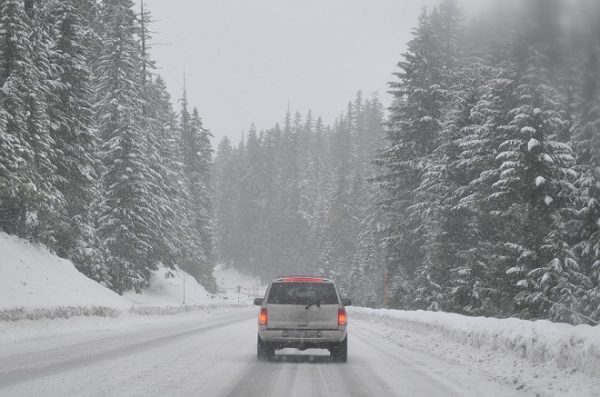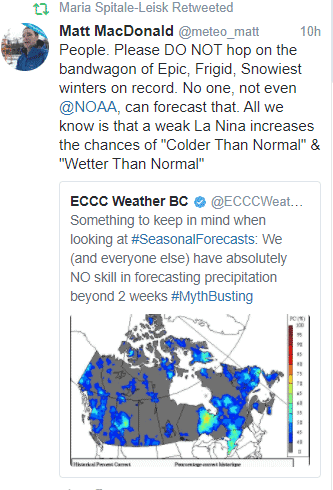
 ’Tis the season for seasonal forecasts. And already Canadians are being told to get set for a whale of a winter ahead. But what’s the real scientific weight behind these ultra-long term weather predictions? Not much, it turns out.
’Tis the season for seasonal forecasts. And already Canadians are being told to get set for a whale of a winter ahead. But what’s the real scientific weight behind these ultra-long term weather predictions? Not much, it turns out.
Earlier this month, officials with the US National Oceanic and Atmospheric Administration (NOAA) proudly announced the successful launch into Earth orbit of a “next-generation” weather satellite, called the Joint Polar Satellite System-1. As the name implies, JPSS-1 is set to travel from North to South Pole and back again, spinning around the globe so fast it makes the trip seven times every day.
The NOAA says the satellite will be used to take in measurements of atmospheric and ground/sea level conditions, cloud cover, snow and ice coverage and a whole bunch more, all in aid of more accurate weather forecasting.
So, just how far ahead are we talking here?
Long term weather predictions? Try seven days, that’s about as far as we can see…
“Building and launching JPSS-1 underscores NOAA’s commitment to putting the most scientifically advanced satellites as possible into orbit, giving our forecasters – and the public – greater confidence in weather forecasts up to seven days in advance, including the potential for severe or dangerous weather,” said Stephen Volz, Ph.D., director of NOAA’s Satellite and Information Service.
Seven days. That’s it, folks.
Still, none of us can resist the lure of the generalized, vague but still suggestive seasonal forecast, not even the NOAA, themselves, whose Climate Prediction Center recently prognosticated that with La Niña expected back this year, the US should see a warmer winter in the South and East Coast and possibly cooler and wetter weather in the northern states bordering Canada.
“If La Niña conditions develop, we predict it will be weak and potentially short-lived, but it could still shape the character of the upcoming winter,” said Mike Halpert, deputy director at the Climate Prediction Center.

Not to be outdone, the Weather Network in Canada has come out to say that this year’s La Niña is shaping up to be similar to the one witnessed in 2007-08, which produced stormy conditions across the country and the snowiest winter on record for places like Toronto.
“Buckle up, because it looks like a stormy winter,” says Chris Scott, the Weather Network’s chief meteorologist, who says that there should be some “high-impact” weather for much of Canada, with a good mid-winter break at some point.
How much truck should we put in all this? Some.
Seasonal predictions are based on real science, using data from past years and comparing it to current conditions. Most importantly, these forecasts look to prevailing and globally influential atmospheric and oceanic trends, such as the well-known El Niño Southern Oscillation and the North Atlantic Oscillation.
But these phenomena allow for only generalized information. Warmer water temperatures in the Equatorial Pacific (in the case of the Southern Oscillation) can produce warmer weather over upcoming months, an El Niño, and cooler waters often lead to cooler temperatures, La Niña.
And translating that into a weather forecast for any particular year is not possible. Here is Jaci Brown, Senior Research Scientist with the Commonwealth Scientific and Industrial Research Organisation in Australia talking to the Conversation about seasonal forecasting.
“Predictability would be even easier if all El Niños and La Niñas were the same, but of course they are not,” says Brown. “Not only are the events different in the way they manifest in the ocean, but they also differ in the way they affect rainfall over Australia – and it’s not straightforward.”
And here’s a tweet from Environment and Climate Change Canada responding yesterday to the media chatter about the supposed stormy winter ahead. “Something to keep in mind when looking at #SeasonalForecasts: We (and everyone else) have absolutely NO skill in forecasting precipitation beyond 2 weeks #MythBusting.”
Lastly, take a look at the NOAA’s own predictions for last year, which turned out to be similar to what they’re offering this winter: for the US, warmer temperatures across the South and cooler across the Northern Plains.
How did they do in hindsight? The Southern US did get a milder winter but because of fluctuations in the Jet Stream (unpredicted ones, note) that colder weather landed on the West Coast instead, hitting places like Seattle and Vancouver with, as we all remember, big time snow. Unexpectedly.
Leave a Reply
You must be logged in to post a comment.



 Share
Share Tweet
Tweet Share
Share




Comment